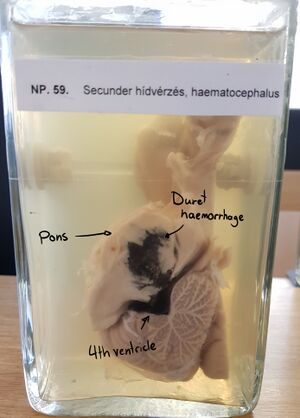34. Secondary hemorrhage of the pons, hematocephalus
Organ: Brainstem
Description:
The 4th ventricle is filled with blood. There is a bleeding in the parenchyme of the pons.
Diagnosis: Haematocephalus and secondary pontine haemorrhage (Duret haemorrhage)
Causes:
- Increased intracranial pressure -> herniation
Theory:
Haematocephalus refers to the presence of blood inside the ventricles.
A Duret haemorrhage is a haemorrhage of the parenchyme of the pons or mesencephalon that occurs due to a transtentorial herniation due to increased intracranial pressure. The herniation causes small vessels in the pons to rupture.
The haematocephalus can be the cause of the Duret bleeding, or it could be a consequence of something else that increased the intracranial pressure.

